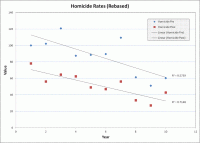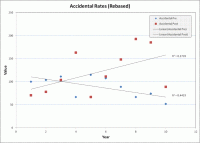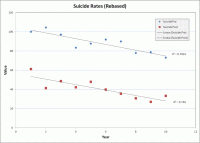Guns Don’t Kill People, Statisticians Do
Last week the US Senate failed to enact the proposed gun reform laws that Obama and others were pressing to get through Congress. The response to this from some in the United States was of horror and disbelief, but sometimes made quite intelligently like the video below.
Of course John Oliver’s argument about drugs is not apples and apples because guns can be used to defend yourself (in the way that a spliff can’t), but others have made the point that even if the Australian law in 1996 reduced mass shootings, the overall trend in Australia for gun deaths at the time was downward at the time and so the 1996 gun ban made little real impact in an overall long-term decline. I mean, look at the Australian gun death figures produced by the American shooting lobby.
Enter the Statistician. There is a very easy way that we can check whether the 1996 law change made a significant difference in gun deaths in Australia by examining the rate of decline of deaths before and after the law change. If they are significantly different then we can say that, yes, the gun law change did reduce gun deaths. If they aren’t significantly different then we reject the idea that the 1996 law affected gun deaths.
Makes sense? Let’s get to it.
For each of the three charts, click on them to view them full-size. My original data set is here so you can check my math if you want.
Suicides
I did a linear regression on the 10 years prior to and following the 1996 law change. I rebased each ten year period to the opening year so there was a fair comparison of percentage change over the period (if gun deaths had already fallen rapidly then absolute values would be smaller in the second period). These were the results.
For the ten years prior to 1996 the suicide deaths co-efficient was -2.999 and the upper and lower 95% bounds of the co-efficient were -1.707 and -4.292 respectively. For the ten years after 1996Â the suicide deaths co-efficient was -2.846 and the upper and lower 95% bounds of the co-efficient were -1.456 and -4.235 respectively. These values are so close that we reject the notion that there was any significant difference in the pre and post gun law change rates of suicide.
Homicides

For the ten years prior to 1996 the homicide deaths co-efficient was -5.720 and the upper and lower 95% bounds of the co-efficient were -1.701 and -9.738 respectively. For the ten years after 1996 the suicide deaths co-efficient was -4.242 and the upper and lower 95% bounds of the co-efficient were -2.058 and -6.427 respectively. These values are so close that we reject the notion that there was any significant difference in the pre and post gun law change rates of suicide. Interesting, the rate of decline in the homicide rate was lower after the gun law change.
Accidental

For the ten years prior to 1996 the accidental deaths co-efficient was -4.871 and the upper and lower 95% bounds of the co-efficient were -0.408 and -9.334 respectively. For the ten years after 1996 the suicide deaths co-efficient was 8.260 and the upper and lower 95% bounds of the co-efficient were -2.706 and 19.226 respectively. This means that after the gun law change on average year on year accidental gun deaths went up for a decade. Although there is a cross-over of 95% bounds, we are confident at around the 90% level that these two trends (pre and post gun control laws) are different enough to suggest a change correlated to the law amendments in 1996.
Conclusion
The contention in the video clip above was that gun related deaths declined in Australia after the 1996 legislation changes. Whilst that may have been true for large massacres (four or more dead) and whilst the numbers of gun deaths did drop after 1996, the rate of drop was not significantly different to that in the decade before. The claim that the 1996 law changes led directly to the drop in gun deaths does not hold much substance.
It’s worth noting that I started this work hoping for the opposite result. Here in the UK we are instinctively pro-safety on this issue and after the Dunblane Massacre the subsequent gun restrictions were welcomed almost unanimously across the nation. However, the evidence from Australia seems to indicate that, at least in that rural outdoors environment, introducing restrictions on gun ownership had no observable effect on gun deaths.
Of course, it might not be the guns’ fault…

Out of interest, what was gun ownership like in Australia before the ban? Like the UK (rare) or US (common)? Instinctively I’m on the side of a ban, but I can see the argument that in the US the “genie is out of the bottle” – a ban tomorrow without a register means you’d have a very low chance of recovering all the guns already in circulation, whereas here it’d be very different.
Good question. I believe somewhere in between. Remember, most of Australia was settler country till the 20th Century (and some of it well into it) so protection in the wild was a necessity.
Are you able to do this analysis for the UK?
Gerv
You mean pre and post Dunblane? If the equivalent figures were available, yes.
I recall reading something on this once and I believe there was a clear link between gun deaths pre and post. But what that seems to suggest is that the more widespread gun ownership is in a society, the less likely a ban will have any meaningful effect on death rates.
I think the data you need is in here:
http://www.parliament.uk/briefing-papers/sn01940.pdf
Just eyeballing it, gun deaths rocketed after the ban was introduced, but are now back down where they were. So I’d be interested to know what a proper statistical analysis tells us.
Fatal injury figures are only available from 2002 onwards in that paper
The paper says that figures from before that time are not directly comparable due to a change in criteria for recording them. :-|
The vimeo link has disappeared – you need this http://www.youtube.com/watch?v=9pOiOhxujsE instead, for the time being.
Thanks – fixed!